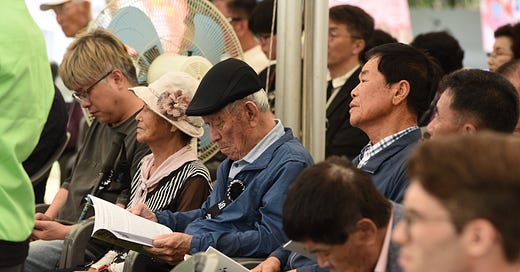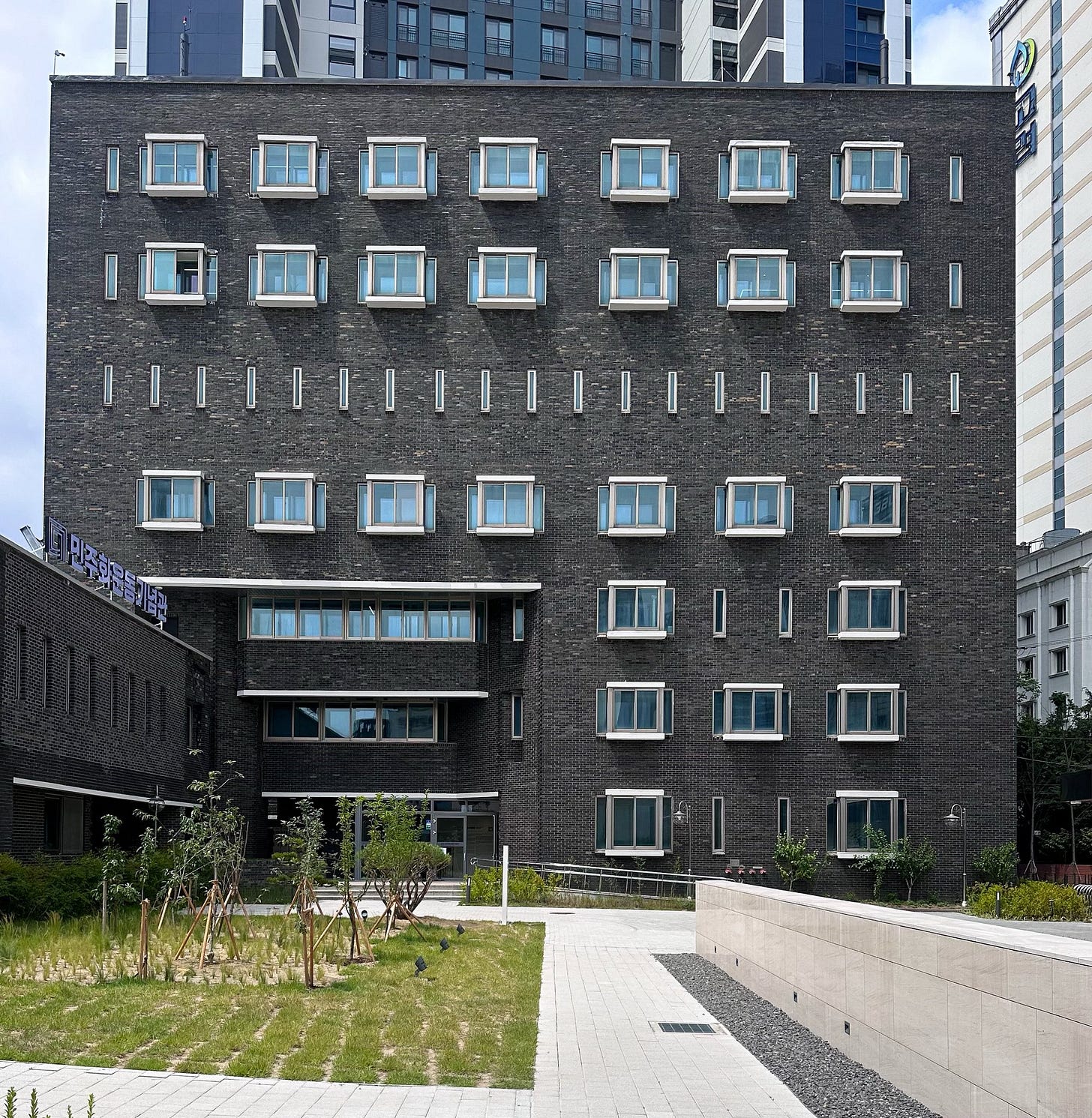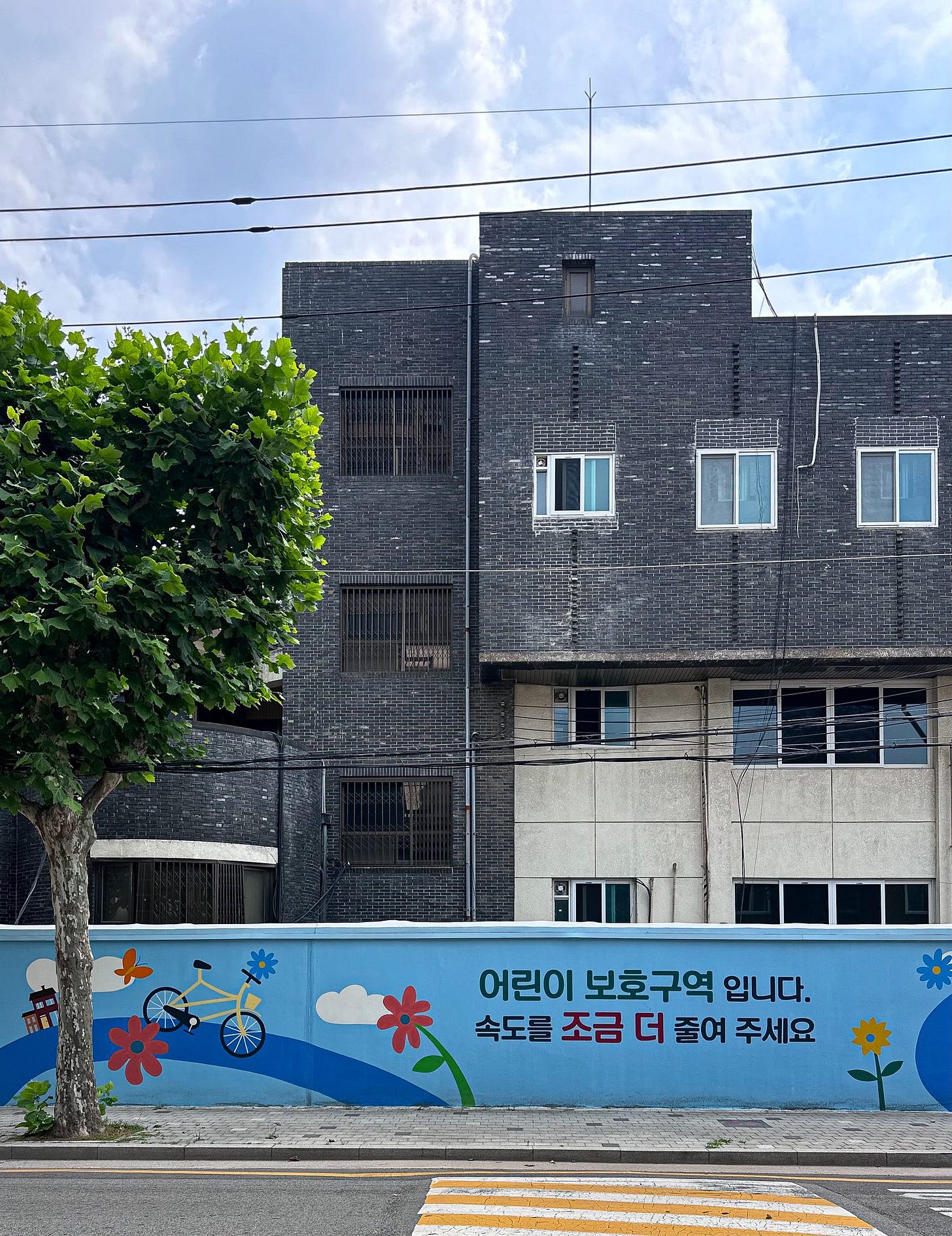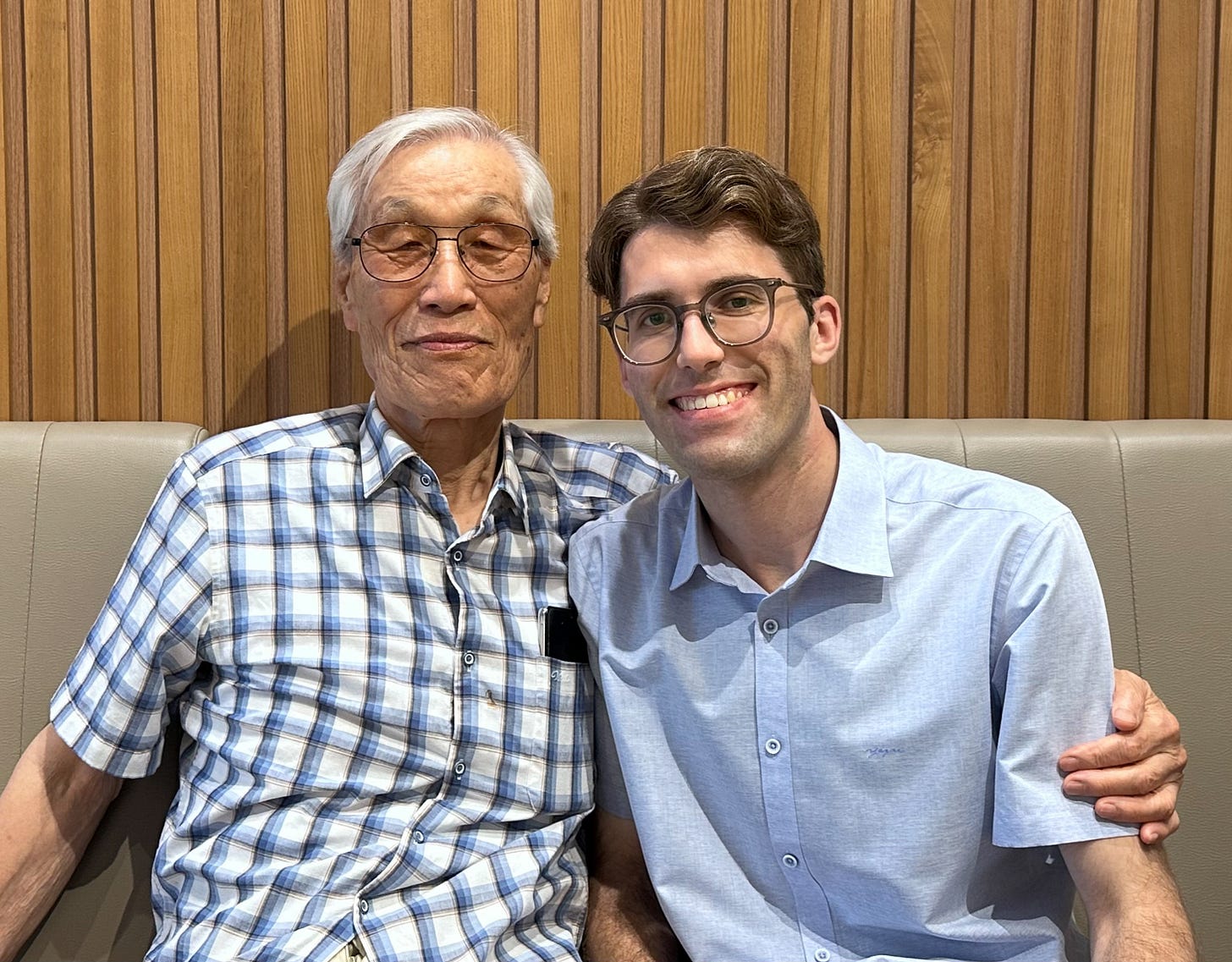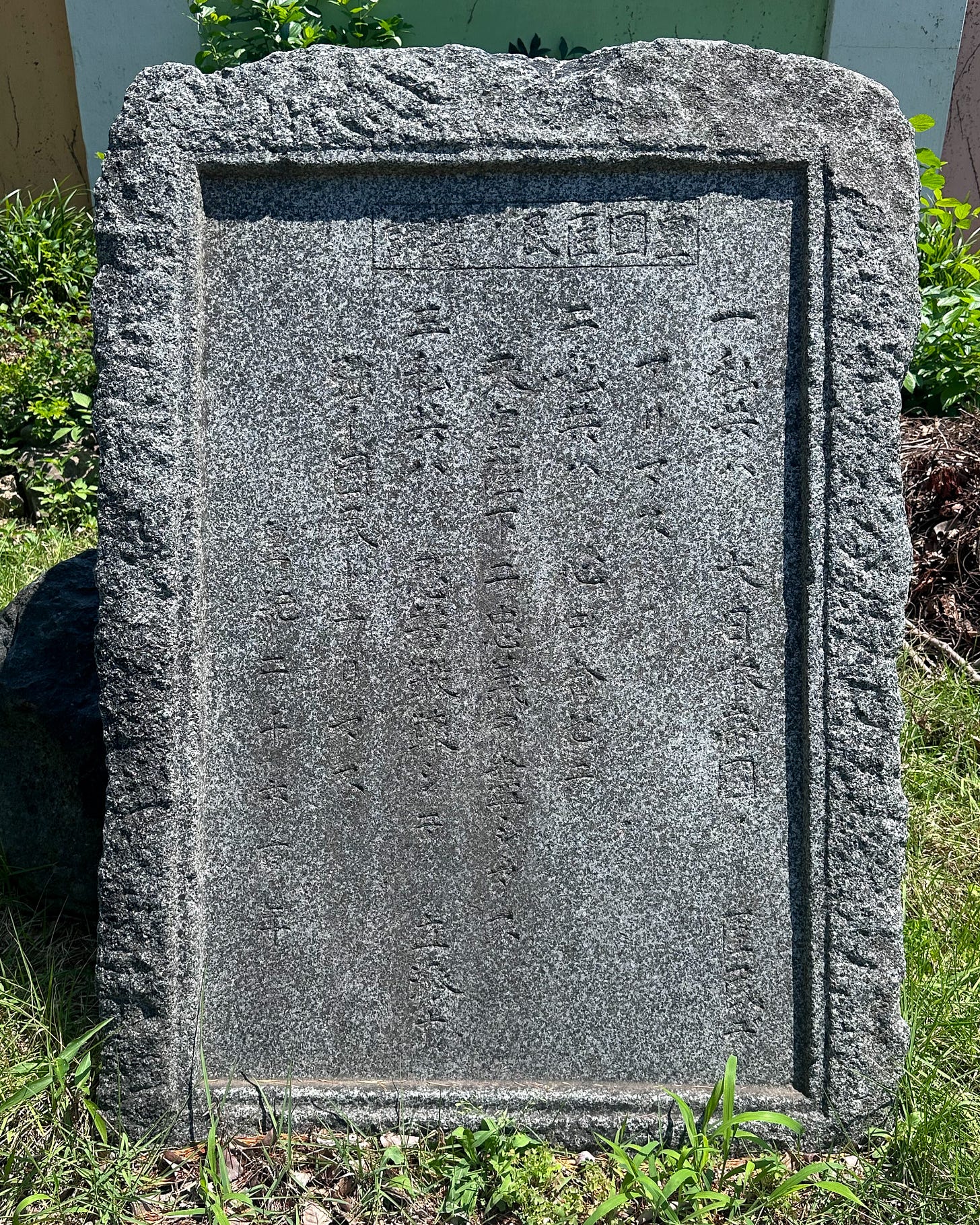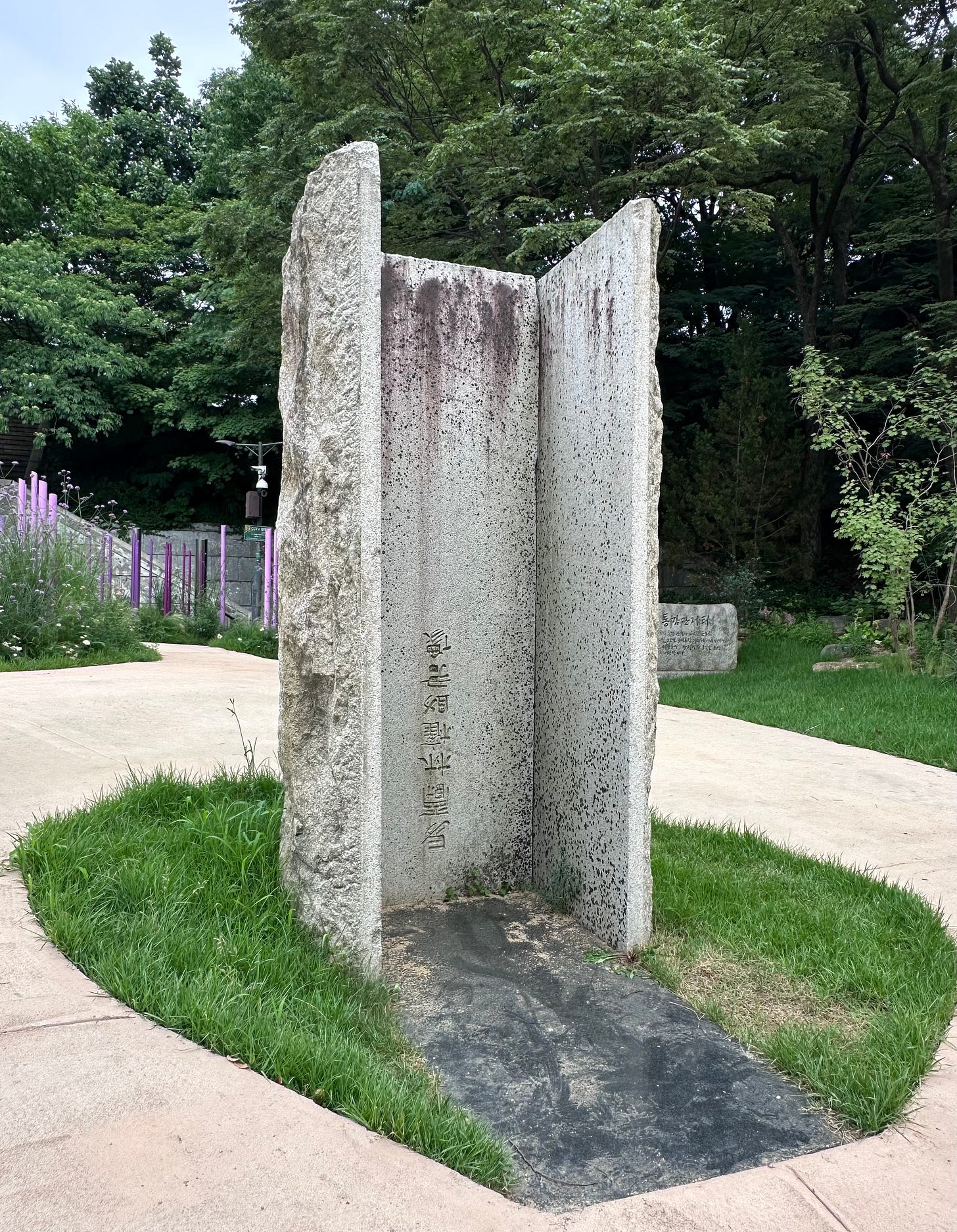Hello readers,
I apologize for the delay in writing this newsletter. I had planned to publish an issue after returning from Japan, but several things got in the way.
Besides presenting my research on the Gyeongsan Cobalt Mine Massacre site at the International Heritage Seminar, I visited several sites related to Korean-Japan relations and Koreans in Japan. These include the controversial Meiji Industrial Heritage Information Centre, Mindan’s History Museum of J-Koreans, the Great Kanto Earthquake Memorial Hall and sites related to the massacre of Koreans, and the Women’s Active Museum on War and Peace. Each deserves its own essay, but that will have to wait. I will share more as I take the time to gather my thoughts.
In the meantime, I hope you find something of interest in this issue, which focuses on how memory, history, and contested spaces shape South Korea’s ongoing struggles with democracy, identity, and the legacies of past oppression.
Preserving the Geumseong Shrine Ritual
In the last newsletter, I mentioned that the Geumseong Shrine ritual was scheduled for June 14. Although I couldn’t attend since I was in Japan, I had written an article in advance about the organizer, Yang Jong-sung, and his journey as a collector of shamanic artifacts after nearly becoming a shaman himself. The piece explored the challenges he faced in founding the Museum of Shamanism and his ongoing efforts to preserve the Geumseong Shrine rituals. While the museum has quietly returned to his home following the termination of the MOU with Eunpyeong District, it’s a good thing that the gut has been able to continue and bring the community together.
Dictator Statues and Public Space
Another piece I mentioned in the last newsletter was finally printed in The Korea Times following the conclusion of the presidential election. I wrote about how right-wing forces are using both public and private funds to memorialize past dictators, namely Park Chung Hee and Rhee Syngman. The projects I examine in the article aim to claim public spaces and are part of a broader strategy to dominate historical narratives.
One update regarding the Daegu case is that plans for the second statue have been temporarily suspended due to internal discussions within the city administration. The project has not been scrapped entirely, and the budget allocation remains intact. The main reason for the pause is that no one is actively pushing it forward since Hong Joon-pyo, who had spearheaded the effort, resigned to campaign for the PPP presidential nomination.
The city council declined to examine the repeal ordinance during its June session, citing a lack of time to properly review the matter - a likely excuse to stall the process. However, some council members have reportedly hesitated to move forward because they believe the face on the statue more closely resembles Hong than Park.
This prompted renewed protests from civil society, as well as heightened demands for the removal of the existing statue at Dongdaegu Station. A conference on the issue, organized by the Daegu branch of People’s Solidarity for Participatory Democracy (PSPD), is scheduled for July 10.
Meanwhile, the Daegu District Court was scheduled to hear oral arguments on July 3 in a lawsuit filed by Korail against the city over ownership of the station plaza where the statue now stands. If the court orders the city to restore the plaza to its original state, the statue would likely have to be relocated.
Past and Present in Cheongnyangni
On the afternoon of June 28, I led an outdoor excursion for the first time on behalf of the Royal Asiatic Society Korea Branch. Although the heat was intense, the rain held off, and a good group came together to hear stories from the past and present of Cheongnyangni, the unique and rapidly changing neighborhood I call home in Seoul. We started at the rail station, continued to the site of the former Cheongnyangni Mental Hospital, spoke about the legacy of 588, which was once one of Asia’s largest red-light districts, explored the Hongneung Revival Housing complex built after the Korean War to address housing shortages, and navigated through the bustling market alleys where medicinal herbs, produce, and a wide range of other goods are sold.
Before the tour, I was asked to contribute a short article to The Korea Times that offers more background about the area. It gives a sense of what we saw and talked about on the walk. I hope to offer the tour again in the future, along with others, if there is continued interest.
The Last Memorial at Golryeonggol
Last week, the joint memorial service for victims of the civilian massacre at Golryeonggol in Daejeon’s Sanne-dong was held, likely for the last time at the site. This is because ground may finally be broken for the creation of a Peace Park, although disputes remain among bereaved families, and the state, over how the exhumed remains will be enshrined.
Over the past few weeks, I’ve been reading through declassified American documents concerning executions carried out by Korean military, government, and paramilitary forces following the outbreak of the Korean War. Again and again, these documents show that executions occurred without trial. The people killed were not always subversives or Communists, but often simply opponents of the Rhee government. Interrogations were brutal, and the resulting information was often unreliable or unverifiable.
Later, U.S. and U.N. forces insisted these executions fell under Korean sovereignty and had been approved by legally constituted courts, even when some trials reportedly lasted no more than ten minutes. Efforts were made to deflect responsibility by claiming the other side was more brutal, that reporters were naive or emotional, or that the U.S. and South Korea were merely co-belligerents rather than formal allies.
Getting to the truth is difficult. There is a lack of non-biased sources. But it is clear that inhumane acts were committed. Families were torn apart. People suffered grave injustices in a genocidal war. Remembering this does not degrade the sacrifices of good soldiers in the ROK and UN forces who tried to perform their duties, speak out against the cruelties, and stop such acts when they encountered them. We need to remember the Korean War warts and all, and how it has left lasting, miserable impacts on so many people across the country.
For the bereaved families of the victims - most of whom were political prisoners at Daejeon Prison or members of the National Guidance League - the trauma did not end with the killings. Many later became subject to the guilt-by-association system. Though that system no longer exists, the pain of being unable to grieve openly or honestly continues to weigh heavily.
For many, the truth also remains out of reach. The Truth and Reconciliation Commission has now ended its second mandate. Some families never had the chance to apply. Others did, but their cases were not processed. They continue to fight for the truth, for dignified memorial spaces, for exhumations, and for forensic testing.
Remembering this history and passing its lessons to future generations is the only way to move forward. This remains true even in the face of ongoing historical distortions and efforts to downplay or erase the truth. It is as important as ever, especially as we continue to witness wars, mass graves, and the killing of civilians around the world.
Namyeong-dong and the Architecture of Repression
On June 11, the former Namyeong-dong Anti-Communist Interrogation Office reopened as the new National Museum of Korean Democracy. It is managed by the Korean Democracy Foundation, a nonprofit affiliated with the Interior Ministry. While the reopening is overall a positive development, there remains some discontent over Lee Jae-oh continuing as head of the foundation. He was appointed by Yoon Seok Yeol, and questions have been raised about his self-promotion through the prominent display of artifacts related to himself in the museum. I visited the day before the public opening, just before taking off for Tokyo.
The building was commissioned in 1976 by Interior Minister Kim Chi-yeol, who awarded the contract to the architect Kim Swoo-geun and his firm, SPACE Group. Like other anti-communist interrogation offices under the National Security Headquarters, it operated under a false name, the “International Oceanic Research Institute,” to conceal its actual function.
Originally built as a five-story structure, it was expanded during the Chun Doo-hwan regime in 1983 with two additional floors. On November 23, 1977, Lee Young-hee became the first person to be tortured at the site. The narrow windows on the fifth floor were designed to prevent detainees from being pushed out or from throwing themselves out. Most people who know of the building associate it with Seoul National University student Park Jong-cheol, who was killed during an interrogation in 1987. As Clyde Haberman wrote in the New York Times on January 31 of that year, “The policemen had shoved [Park’s] head several times into a tub of water. In one of those dunkings, the government said, Mr. Park's throat was crushed against the rim of the tub. He was suffocated.” Outrage over Park’s death helped spark the nationwide June Democratic Movement.
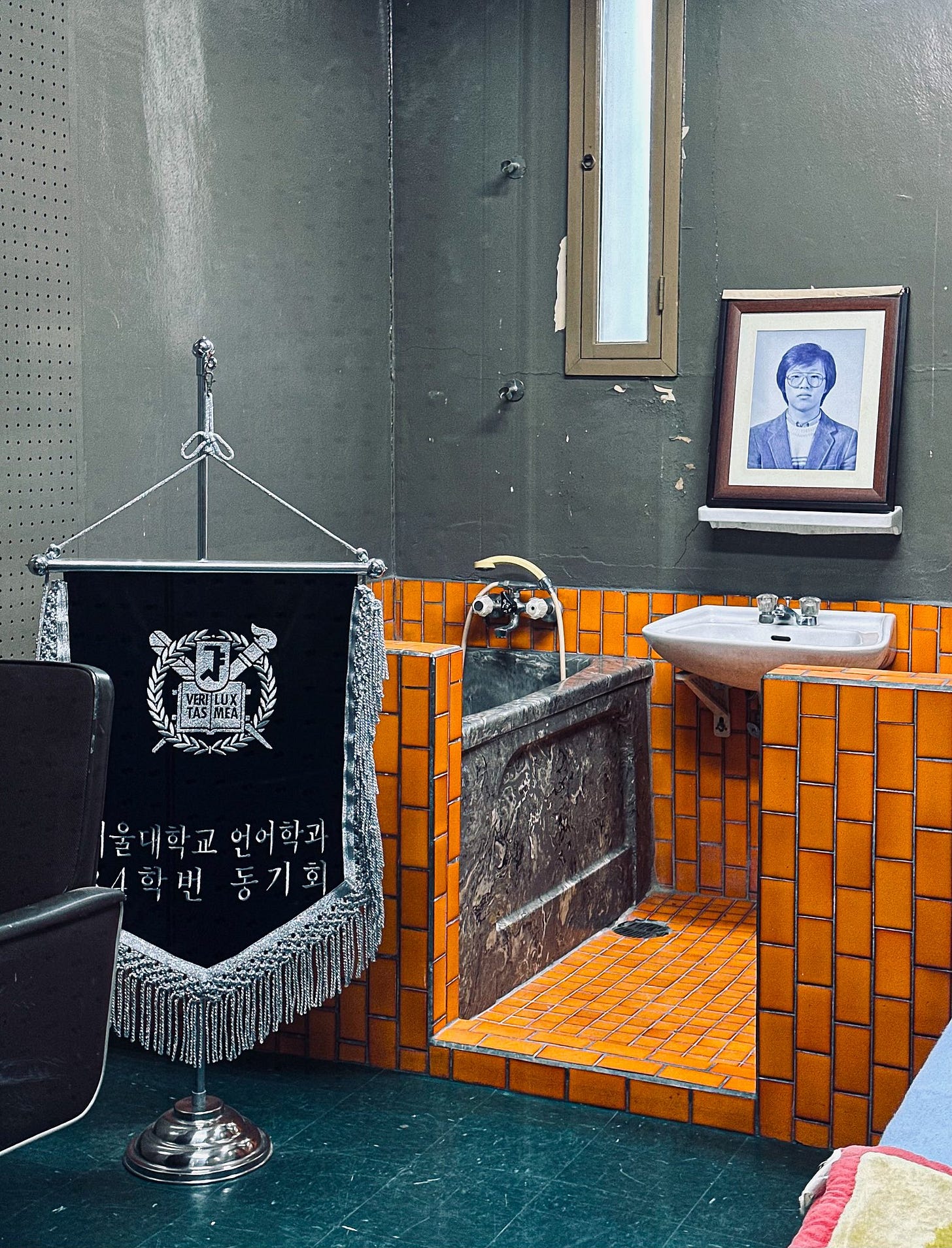
The architectural choices at Namyeong-dong reflected a broader system of physical and psychological control. In 2001, it was revealed that Professor Tsche Chong-kil of Seoul National University School of Law, who died under suspicious circumstances while being interrogated by the Korean Central Intelligence Agency in 1973, had in fact been pushed from a seventh-floor window by the officer in charge. His death, long described as a suicide, was later reclassified as a state killing by the Presidential Truth Commission on Suspicious Deaths, a predecessor to the current Truth and Reconciliation Commission.
After Park Jong-cheol's death, the building was renamed the Security Detached Office of the National Police Agency in 1991. It was repurposed in 2005 as the Human Rights Center of the National Police Agency and remained in that role until relocating to Hannam-dong in 2018.
In addition to restoring the original structure, a new annex has been built with exhibit and seminar spaces. The museum's current exhibits trace the history of the democratization movement across various sectors, including the arts, labor, and environmental activism. Testimonies from those who were tortured or abused under the dictatorship are featured prominently. The hope is that more people will come to understand not only the difficult road that South Korea took toward democratization, but also how democracy remains an unfinished project that requires ongoing defense and engagement.
Since the opening, I’ve returned once to attend a lecture by architectural historian Ahn Chang-mo. He discussed the building’s history as well as the broader imprint Park Chung Hee left on Seoul’s architecture and urban development. Ahn highlighted how the Chun Doo-hwan regime’s expansion of detention and interrogation facilities reflected the growing repression of the time. One of the sites he mentioned was the “대공분실” in Jangan-dong, Dongdaemun District. Built in 1986, it shares the same black brick motif as the Namyeong-dong site. This interrogation office operated under the cover name “Kyongdong Industries.” I had actually visited this building shortly after returning from Japan earlier this year.
I first learned of the Jangan-dong site during an interview with the artist Shin Hak-chul, who was detained there for violating the National Security Law in connection with his painting Rice Planting. He recalled that figures like Father Moon Kyu-hyun and Lee Jae-oh were also interrogated there.
From Ahn’s lecture, I also learned that the Community Chest of Korea building on Sejong-ro in Jeongdong was originally a branch of the Korean Central Intelligence Agency. It was sold off after Park’s assassination and had also been designed by Kim Swoo-geun. Kim was no passive participant. He designed these buildings to meet the expectations and vision of his patrons. He knew what they were for. At the same time, he created them using the architectural language he was working with at the time, including the material and formal choices that defined his broader practice.
The architectural community remains hesitant to fully reckon with Kim’s role in creating sites of authoritarian control. But confronting this legacy is essential. Buildings like these are not just structures; they have served as instruments of tyranny. Recognizing their histories helps us understand how architecture can serve both oppression and resistance. After the past six months of political turmoil and now with the election of a new president, Namyeong-dong reminds us once again of the importance of reckoning with history honestly. It shows how fragile democracy can be and why protecting it requires constant vigilance. The painful memories of torture held within these walls are a call to never repeat the mistakes of the past.
Traces of the Oath, Memories of Facing East
Since Jenna and I first met Jo Gyeong-ho in Yeongcheon last October, we have had the chance to visit him regularly and gradually learn more about his life. Our unexpected meeting in the pouring rain felt almost like fate. As we got to know him, we discovered a few surprising connections. Jo and I attended the same university, decades apart. He and Jenna also share the experience of having lived in Australia. Jo was born in the same year as my maternal grandfather, who passed away last year. Beyond similarities in personality, we have often said that Jo even resembles my grandfather in appearance—a Korean version, in a way.
In one of our early conversations, he shared a vivid childhood memory from the Japanese colonial period: worshiping the emperor at school. During morning assemblies, he and his classmates, like students across the country, were made to face east and bow toward Tokyo. “They said he wasn’t just a king, but a god,” Jo recalled. Under the ideology of State Shinto, the emperor was deified. This was part of a broader disciplinary regime designed to suppress Korean identity and instill loyalty to the empire.
Students were required to memorize and recite the Pledge of Imperial Subjects (황국신민서사). There were different versions for children and adults, but the core message was the same: you are not Korean, but Japanese subjects, and your duty is to sacrifice for the emperor.
Children’s Version:
We are subjects of the great Japanese Empire.
We will unite our hearts and show loyalty and devotion to His Majesty the Emperor.
We will endure hardship and train ourselves to become admirable and strong citizens.
General (Adult) Version:
We are imperial subjects. With loyalty, we will repay our sovereign nation.
As imperial subjects, we will act with faith, love, and cooperation to strengthen unity.
As imperial subjects, we will endure hardship and train our bodies to cultivate strength and glorify the imperial way.
(Source: Daegu History and Culture Encyclopedia, Korean Studies Central Research Institute)
One of the more disturbing details Jo remembered was that at the school gate, students also had to step on stones inscribed with “America” and “England." They were taught that Roosevelt and Churchill were “human trash.” They were literally trained to trample the enemies of imperial Japan. It was a form of indoctrination, through a daily act of symbolic violence.
As he told us this, he spoke with a mixture of shame and lingering confusion. He had been told by his teachers not to speak Korean, that Koreans must take a Japanese name, and to believe that Korea no longer existed. Students who obeyed were rewarded. Those who resisted were punished. But in the end, whether they complied or not, the cost was the same: beyond being forced to bow to another nation's god, they were made to reject core parts of themselves and grow up with a fractured sense of identity.
With Jo’s story in the back of my mind, I wondered, were there any physical traces left of the Pledge of Imperial Subjects? As it turns out, several steles inscribed with the pledge still exist across Korea. One of them happens to be in Dalseong County, a rural part of Daegu, not far from Yeongcheon. Jenna and I recently drove out to see it.
At the more than 100-year-old Hyeonpung Elementary School, we found the stele tucked off in a corner of the yard. The text is now faint, but you can still make it out in the right light. A placard stands beside it explaining its history in brief. According to citizen reporter Song Eun-seok’s March 2020 article in Yeongnam Ilbo, a signboard had previously been installed in 1999, but at some point after that the monument was left lying on the ground, covered in dirt and played on by the children. The signboard disappeared without a trace. This may have happened because of a school improvement project. The stele was only rediscovered in 2011, and even after that it took extensive consultations with the community before it was agreed to keep it in place and preserve it again.
After attending the recent wiryŏngje in Daejeon, I had a bit of time to walk over to the Hanbat Museum of Education to see a similar stele located there. I don’t think the condition is as good as the one in Dalseong, and while the museum version is a bit more accessible, I also think it was a better choice to keep the Dalseong stele in its original location. Even if it’s tucked away and not as widely seen, its presence on the grounds of a functioning school carries a different kind of weight. It reminds us that this history didn’t unfold in abstraction but in everyday spaces, where real children once were made to stand and recite those words.
When it comes to the colonial period, there will always be debate about whether remnants like this should be preserved, and if so, how. Last weekend, as I took a walk near the foot of Namsan, I remembered that the remains of a statue of Hayashi Gonsuke had been installed there upside down about a decade ago. Hayashi was a Japanese diplomat who threatened King Gojong’s ministers, coerced the signing of the Eulsa Treaty, and was later made a baron for it. The inscription says the statue's remnants were overturned “to remember the disgraceful event.” It is a more forceful gesture than preserving a stele on a schoolyard, but it too is an attempt to make memory visible and instructive.
It is important not to glorify these remnants, but to use them as educational tools. They reinforce that colonialism was not just a historical practice, but something that was simultaneously embodied and endured by people like Jo. These artifacts, especially the steles, remind us of what previous generations lived through, not in the abstract, but in ritual and through everyday submission.
What Happened in Winnipeg on February 19, 1942
Sometimes I come across things that have nothing to do with my main research interests but still catch me by surprise and seem worth sharing. One of those is a mostly forgotten event in the history of Winnipeg, which I learned about through a Bluesky post by David Fedman featuring photos from Life magazine in 1942.
The event is remembered as “If Day.” It was a staged Nazi invasion of the city, designed to shock the public and drive donations to the Victory Loan campaign in Manitoba. Since I currently have a subscription to Newspapers.com, I was able to dig a bit deeper and read the Winnipeg Tribune's coverage from February 19, 1942, the day the event took place.
Let’s take a closer look at what happened during this grim dramatization, which ended up raising over 3 million dollars through bond purchases.
Starting at 7 a.m., with the temperature more than 15 degrees below zero, Winnipeg went into blackout as 3,500 men from active and reserve duty took part in the exercise. Passengers were pulled from their cars and subjected to checks. Members of the Young Men's Section of the Board of Trade, dressed in Hollywood-supplied uniforms and bucket helmets, carried out the "arrest" of Manitoba Premier John Bracken, seven of his ministers, and the city's mayor. They burned pages from books in a bonfire outside the public library, then stole lunch trays and food from people eating in the Great-West Life Assurance Company cafeteria.
They stormed into a school, arrested the principal, and ordered that only "Nazi Truth" be taught. Coffee shop customers received worthless reichmarks with their change. The whole scene was made to feel real, with roving anti-aircraft gunners in vehicles, fake stormtroopers carrying bayonets and tom
my guns, and carefully timed dynamite charges. It was a psychological shock campaign meant to make the threat of Nazi invasion feel immediate and personal. By staging arrests, censorship, currency collapse, and public humiliation, the organizers turned abstract global conflict into something local and visceral. The goal was to motivate citizens' fear of occupation and of violence on their own streets.
I’m not sure whether to see it as a brilliant success or a disturbing example of coercion, but either way, I found a few amusing clippings that suggest not everything went according to plan. The stolen lunch trays couldn’t be eaten because there wasn’t enough time in the schedule. And the installation of a Gestapo chief at the police station fell through after the stormtroopers showed up late. By then, the officers had already gone to lunch.
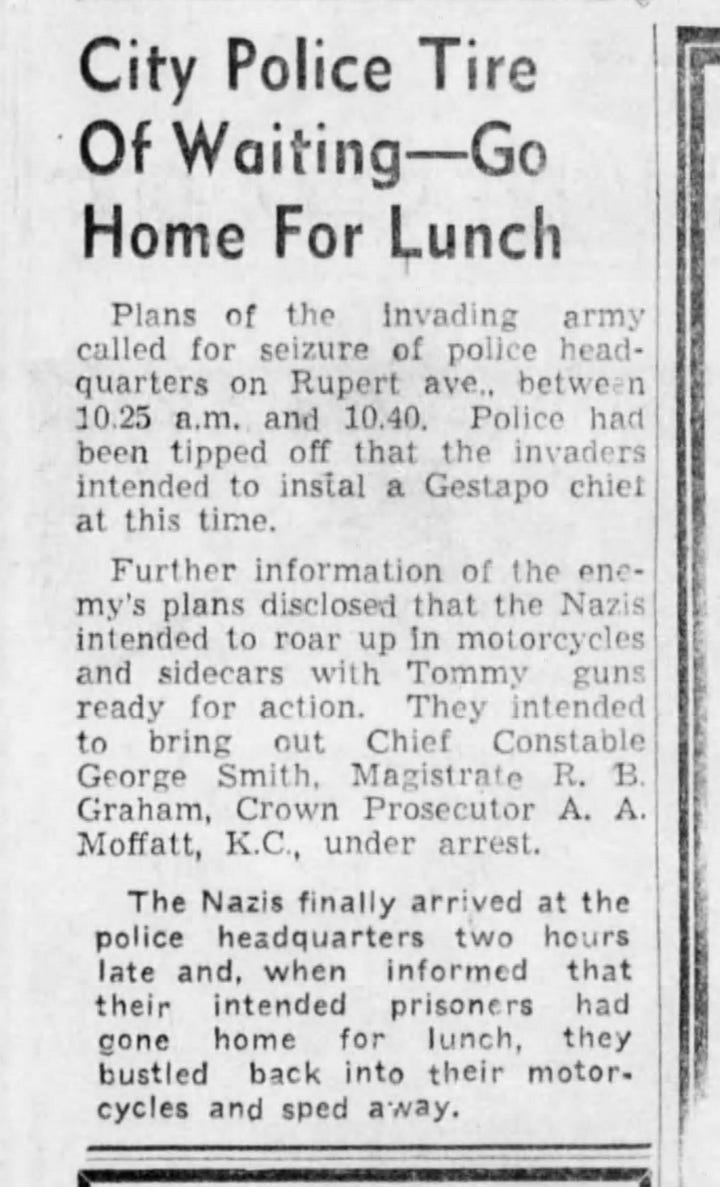

Note: A few edits have been made for clarity and to correct typos since the emailed version of this newsletter was sent.

